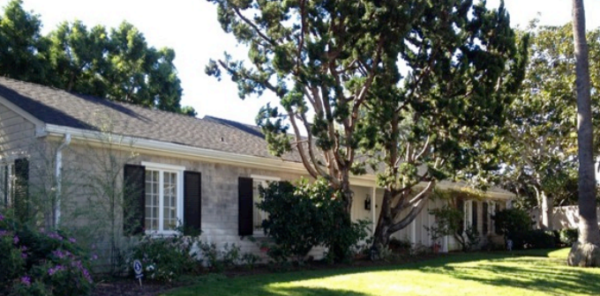By Vonn Marie May
 Thomas L. Shepherd has long been recognized as a Master Architect by the City of San Diego. However, any attempt to characterize his work under a specific architectural style is problematic. One could almost describe his residences or commercial projects as ‘Shepherds’ instead of trying to shoehorn his work into particular style categories. His work drew from several cultural derivations past and present. But one predictable trait indicative of his sense of style is that he pursued quality in detail and genuinely reflected the wishes of his clientele, more so than many other architects or his era were known to do. One can see the style of his buildings as reflective of the time period, or decade, in which they were conceived. An outstanding example is a house designed in 1937 for Fayette & Hannah Bousfield, which is truly an innovative early version of the California Ranch style but with Shepherd’s affinity for the 1930s American Colonial style.
Thomas L. Shepherd has long been recognized as a Master Architect by the City of San Diego. However, any attempt to characterize his work under a specific architectural style is problematic. One could almost describe his residences or commercial projects as ‘Shepherds’ instead of trying to shoehorn his work into particular style categories. His work drew from several cultural derivations past and present. But one predictable trait indicative of his sense of style is that he pursued quality in detail and genuinely reflected the wishes of his clientele, more so than many other architects or his era were known to do. One can see the style of his buildings as reflective of the time period, or decade, in which they were conceived. An outstanding example is a house designed in 1937 for Fayette & Hannah Bousfield, which is truly an innovative early version of the California Ranch style but with Shepherd’s affinity for the 1930s American Colonial style.
Thomas L. Shepherd was born in 1897 in Wisconsin. He took an undergraduate degree at the University of Wisconsin then studied architecture at Columbia University in New York. He was greatly impressed by his travels in Europe and the Mediterranean and subsequently developed his approach to architectural design from those influences. He came west and interned under the noted Southern California architect George Washington Smith in Santa Barbara and worked briefly in Pasadena.
Shepherd came to La Jolla in 1926, when it still was being described as art-colony village. That same year he partnered with architect Herbert J. Mann (1927-1932) who had arrived in San Diego in 1925 to establish an office in La Jolla. The new office was described as Mann’s design-build firm, one with several years of experience in the Spanish Colonial architectural style. The first mention of their association in the La Jolla Journal comes in an 8 September 1927 article stating that Herbert J. Mann and Thomas L. Shepherd were designing a home in the Muirlands for Mr. and Mrs. Lester Palmer of Dallas, Texas.
Shepherd’s first independent mention in the Journal comes on 11 October 1928 announcing the opening of the Fine Arts Building at 1117 Wall Street, which later became his primary architectural offices (extant). In the 24 January 1929 issue was the first notice of a Shepherd project in the La Jolla Hills subdivision, a home for Ada C. Black at 7781 Hillside Drive, which is ‘to appear in a magazine’ (Country Life of America). Later, Shepherd would rise to greater prominence than his former partner. Herbert Mann often provided construction support for many of Shepherd’s projects as their roles in the design world changed. By the early 1930s Herbert Mann seems to disappear from the San Diego scene, rumored to have relocated to Los Angeles, and Shepherd began his private practice at 1117 Wall Street in La Jolla.
Shepherd began designing homes predominantly in La Jolla within prestigious subdivisions such as the Barber Tract, La Jolla Hermosa Units 1 & 2, and the Muirlands. In La Jolla Hermosa, Edgar V. Ullrich, another recognized San Diego master architect, was the official tract architect who worked closely with the younger architect. Shepherd was known especially for customizing his designs to suit the lifestyles of his clientele. According to Thomas Jamison, writing in the Journal of San Diego History:
Shepherd claimed to prefer no singular style, but rather designed for the particular needs and tastes of the owner. He disavowed any regard for architectural conformity. Extensive travels throughout Japan and Europe allowed Shepherd further design possibilities.
He finally built his own home, for him and his wife Ruth, in his beloved La Jolla Hermosa in 1947. Many commissions followed up through the 1970s. Shepherd’s Marine Room and the La Jolla Beach and Tennis Club are significant landmark buildings from this period that define La Jolla’s character. His last project was a remodel of an Edgar Ullrich-designed house — a full-circle back to his one-time mentor. The residence was originally designed by Ullrich in 1928 and was respectfully remodeled by Shepherd in 1979, a blend of two masters. In later years, Shepherd would describe the La Jolla that he helped create as “a community of conservative and classic quality.” Thomas L. Shepherd died December 9, 1979.
 The Fayette & Hannah Bousfield / Thomas L. Shepherd / Abbe Wolfsheimer House (1937) – Photo: Vonn Marie May
The Fayette & Hannah Bousfield / Thomas L. Shepherd / Abbe Wolfsheimer House (1937) – Photo: Vonn Marie May
Sources:
Jamison, Thomas A.: “La Jolla Hermosa: A Subdivision Triumph”; Journal of San Diego History, Vol. XXXI, No. 3, Summer 1985, San Diego Historical Society
La Jolla Historical Society Archive
San Diego, City of: Modernism Context Statement; 2007
Schaelchlin, Patricia A.: La Jolla: The Story of a Community 1887-1987; The Friends of the La Jolla Library, La Jolla, 1988
